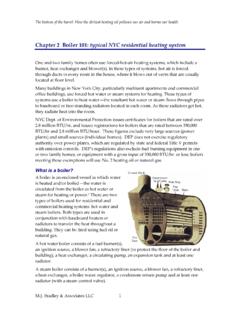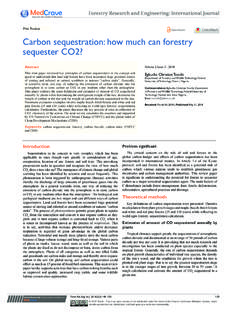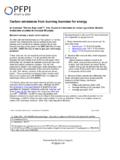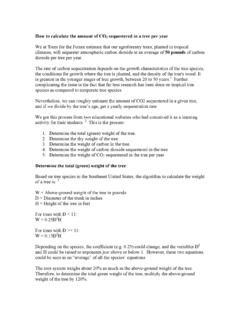Transcription of Measuring Carbon Emissions from Tropical Deforestation--An ...
1 Measuring Carbon Emissions from Tropical Deforestation: An Overview ! Tropical deforestation contributes about 20% of annual global greenhouse gas (GHG) Emissions , and reducing it will be necessary to avoid dangerous climate change. China and the US are the world s number one and two emitters, but numbers three and four are Indonesia and Brazil, with ~80% and ~70% of their Emissions respectively from deforestation. Slowing or stopping deforestation is a near-term, cost-effective option for significantly reducing global Emissions , with extraordinary additional benefits for biological diversity and sustainable development in Tropical nations. Carbon market incentives to stop deforestation can also help US companies and consumers control the costs of a national cap-and-trade system to reduce US Emissions .
2 Accurately monitoring and Measuring Emissions from deforestation is necessary to creating effective incentives for Tropical countries to control and stop the process. The attached paper by remote sensing scientist Dr. Gregory P. Asner1 shows that technologies and methods already in use in nearly half of the world s Tropical forests accurately monitor and measure deforestation and forest Carbon , and could be implemented globally now. The major obstacles to accurate global measurements of Emissions from deforestation are political, institutional and budgetary rather than scientific or technical. !" #$ %% & & !" #$ %% ' ( ( & & & & ) ' ( * & * + + *++% , & ( + (.))))
3 % ( , 1 Greg Asner is a faculty member of the Department of Global Ecology at the Carnegie Institution of Washington. He also holds a faculty position in the Department of Geological and Environmental Sciences at Stanford University. His scientific research centers on how human activities alter the composition and functioning of ecosystems at regional scales. Asner combines field work, airborne and satellite mapping, and computer simulation modeling to understand the response of ecosystems to land use and climate change. Asner's most recent work includes satellite monitoring of selective logging and forest disturbance throughout the Amazon Basin, invasive species and biodiversity in Hawaii rainforests, and El Nino effects on Tropical forest Carbon dynamics.)
4 His remote sensing efforts focus on the use of new technologies for studies of ecosystem structure, chemistry and biodiversity in the context of conservation, management, and policy development. He directs the Carnegie Airborne Observatory, a new airborne laser and hyperspectral remote sensing platform designed for regional assessments of the Carbon , water, and biodiversity services provided by ecosystems to society. Measuring Carbon Emissions from Tropical Deforestation: An Overview Gregory P. Asner, Department of Global Ecology Carnegie Institution for Science Summary Tropical deforestation contributes about 20% of annual global greenhouse gas (GHG) Emissions , and reducing it will be necessary to avoid dangerous climate change.
5 Slowing or stopping deforestation is a near-term, cost-effective option for significantly reducing global Emissions , with unparalleled co-benefits for biological diversity and the livelihoods of forest peoples. Accurately monitoring and Measuring Emissions from deforestation is necessary to creating effective incentives for Tropical countries to control and stop the process. Technologies and methods already in use in nearly half of the world s Tropical forests monitor and measure deforestation and forest Carbon to a high degree of accuracy, and could be implemented globally now. The major obstacles to accurate global measurements of Emissions from deforestation are political, institutional and budgetary rather than scientific or technical.
6 This paper provides an overview of current methods and technologies for Measuring and monitoring GHG Emissions from Tropical deforestation. The paper outlines the contribution of deforestation to climate change and international standards for Measuring Emissions from deforestation. It also discusses existing methods and technologies for Measuring large-scale deforestation events (greater than 25 hectares (65 acres) and global deforestation mapping with mid-resolution satellite technology. The paper further examines high-resolution satellite analysis of smaller deforestation events (less than 25 hectares) and new methods for Measuring forest degradation logging, thinning, burning and other disturbances that damage forests and reduce their capacity to store Carbon without entirely removing the forest canopy.)
7 The paper finally summarizes current methods for Measuring forest Carbon along with measurement of rates of deforestation and degradation, the critical metric for estimating GHG Emissions form deforestation. International standards for Measuring forest Carbon and deforestation published by the Intergovernmental Panel on Climate Change (IPCC) indicate how Carbon market incentives for stopping deforestation or degradation can reward only real, verified Emissions reductions. Conservative accounting of forest Carbon , accurate measurement of historical deforestation rates (or baselines ) using existing satellite data, and robust satellite monitoring of deforestation rates can ensure that Carbon market incentives produce real reductions in deforestation Emissions .
8 1. Tropical Deforestation and Climate Change Clearing and burning Tropical forests accounts for about 20% of global annual Greenhouse Gas Emissions , about as much as all of the fossil fuels burned in the US every year and more than the world s transportation sector. China and the US are the world s number one and two emitters, but numbers three and four are Indonesia and Brazil, with ~80% and ~70% of their Emissions respectively from deforestation. Reducing overall Emissions from deforestation in Tropical nations can help avoid dangerous climate change. Most climate scientists think that greatly reducing or stopping Tropical deforestation, while also substantially reducing Emissions from developed and major developing countries fossil fuels, will be necessary to keep warming under 2 C by the end of the century.
9 Climate scientists increasingly regard the two-degree target as the maximum allowable in order to avoid potentially disastrous climate change. Reducing Emissions from deforestation in developing countries may produce Emissions allowances or credits in Carbon markets under the post-2012 global cap-and-trade system under negotiation in the United Nations Framework Convention on Climate Change (UNFCCC) 2. If Tropical countries reduce national deforestation below historical levels, Emissions allowances from reduced deforestation could help developed countries and their industries control costs and take steeper reductions targets. Carbon market credit for reduced deforestation could also generate the funds needed to make living forests worth more in the market than dead ones, thus making large-scale, long-term Tropical conservation possible.
10 Reducing national-level deforestation below historical rates in high-deforestation Tropical counties offers the greatest potential Emissions reductions from the forestry sector, although Carbon sequestration or avoided deforestation projects may help Tropical countries develop the capacity to control national deforestation. Measuring Emissions from deforestation accurately is necessary for deforestation Emissions reductions to trade in Carbon markets, or for any performance-based system to compensate reduced Emissions from deforestation. The UNFCCC has called on nations to begin Measuring and monitoring deforestation rates so that Reduced Emissions from Deforestation and Degradation 3 known as REDD can be included in a global agreement to reduce Emissions .
















